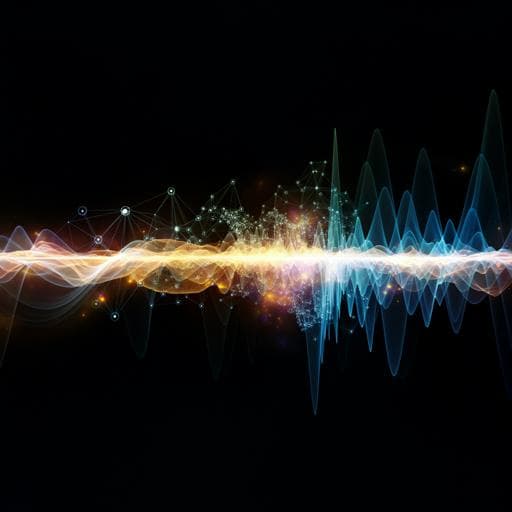
Physics
Machine learning aided carrier recovery in continuous-variable quantum key distribution
H. Chin, N. Jain, et al.
Unlock new possibilities in continuous-variable quantum key distribution with groundbreaking insights on phase noise estimation using an unscented Kalman filter! This exciting research, led by Hou-Man Chin and colleagues from the Technical University of Denmark, demonstrates exceptional stability and low excess noise in experimental setups, paving the way for enhanced CV-QKD systems.
~3 min • Beginner • English
Introduction
Continuous-variable quantum key distribution (CV-QKD) uses the continuous-variable properties of light to enable information-theoretically secure key exchange. Coherent states are modulated in amplitude and phase and transmitted through an insecure channel, then measured via coherent detection (heterodyne or phase-diverse homodyne). Modern CV-QKD typically employs an independent local oscillator (LO) at the receiver to simplify implementation and improve security, which necessitates accurate recovery of carrier frequency and phase. Because the quantum signal is detected at very low SNR and employs Gaussian modulation (lacking discrete constellation features useful to classical carrier recovery), traditional telecom carrier recovery algorithms perform poorly. Pilot-aided techniques are therefore used, transmitting a classical reference (pilot tone) time- or frequency-multiplexed with the quantum signal. Minimizing pilot power is desirable to reduce interference, DAC/ADC dynamic range penalties, and hardware complexity (e.g., avoiding added polarization multiplexing). The research question addressed is whether a Bayesian machine learning approach—specifically an unscented Kalman filter (UKF)—can provide superior phase estimation (carrier recovery) at low pilot SNR, thereby reducing excess noise and enabling higher secret key rates in practical CV-QKD systems. The study implements and experimentally evaluates a UKF-based phase tracker in a Gaussian-modulated CV-QKD system over 20 km fibre using both ultra-low linewidth (≈100 Hz) lasers and a standard telecom laser (≈10 kHz) at the transmitter, comparing against a standard reference method and an extended Kalman filter (EKF).
Literature Review
Recent work has applied Bayesian inference (extended Kalman filter and smoother) for phase tracking in CV-QKD with discrete modulation (8 coherent states), showing benefits over traditional methods. The UKF is expected to outperform the EKF on nonlinear problems at the cost of added complexity. Gaussian-modulated CV-QKD has more mature security proofs but is more sensitive to phase noise due to its higher optimal mean photon number, making robust carrier recovery essential. Bayesian methods have also been used to measure and characterize laser phase noise, demonstrating superior performance in low-power regimes compared to traditional techniques. Classical pilot-aided carrier recovery has enabled key generation in differing settings, but can require higher pilot powers and may not generalize well to low-SNR pilot conditions typical of Gaussian-modulated CV-QKD.
Methodology
Carrier recovery methods: A standard reference method estimates the pilot phase by computing θ_k = arctan(y(k) / H{y(k)}), where H{·} is the Hilbert transform, removing the linear trend to correct frequency offset, and taking the remaining phase noise as the estimate. This method is limited by additive shot and electronic noise at low pilot SNR. Bayesian machine learning approach (UKF): The phase is modeled in a state-space framework. State evolution (Wiener phase noise model): θ_k = θ_{k−1} + q_{k−1}, with q_k as process noise. Measurement model for the pilot in heterodyne: y_k = A sin(Δω k T_s + θ_k) + n_k, with A pilot amplitude, Δω the LO-pilot frequency offset, T_s sampling period, and n_k shot noise. Bayesian filtering computes the posterior p(θ_k | y_{1..k}); the UKF approximates the process with a Gaussian, generates sigma points from its mean and covariance, propagates them through the nonlinear measurement model, predicts the state mean/covariance, and updates via the observed measurement. A Metropolis–Hastings step adapts the Gaussian approximation (including process noise variance), enabling tracking even when model parameters (e.g., linewidth) are initially mismatched. Convergence behavior was studied in simulation for a 2 kHz combined linewidth: underestimating linewidth slows convergence and can limit tracking of fast phase changes; overestimating can cause initial overshoot but settles thereafter. Experimental setup: A Gaussian-modulated CV-QKD system at 1550.13 nm with 50 MBaud quantum symbols (zero-mean, unit-variance Gaussian), upsampled to 500 MSa/s, single-sideband modulated at 60 MHz using an I/Q modulator. A frequency-multiplexed pilot tone at 130 MHz was added at ≈3.2× (≈5 dB) the quantum signal power. The optical signal was attenuated so that the mean photon number at the channel input from the quantum signal alone was N ≈ 2.73 (also a data set at N = 3.41 for the 10 kHz laser). Transmission used either a back-to-back link or a 20-km SMF-28 fibre. Detection used balanced heterodyne with an independent LO (offset ≈200 MHz), LO power 9 dBm; combined shot+electronic noise clearance ≈3 dB above electronic noise; receiver optical efficiency η_det ≈ 0.84. The analog output passed a 200 MHz low-pass and was digitized by a 10-bit DSO at 1 GSa/s, clock-synchronized to the AWG. Frames contained 100k complex symbols plus a 10k-symbol CAZAC sequence for timing, synchronization, and bulk phase compensation. Digital signal processing: Root-raised cosine pulse shaping (roll-off 0.4) and matched filtering were applied. The pilot was bandpass-filtered around its spectral peak; frequency offset was estimated via Hilbert transform of the pilot phase and linear fit of its trend. After refining with the chosen bandwidth, the pilot was shifted to baseband, its argument taken to obtain the time-varying phase, then downsampled to symbol rate for the UKF input. A whitening filter based on measured vacuum (LO-only) spectra was applied to quantum and calibration measurements. Excess noise and key rate estimation: Channel parameters were estimated per frame: e (excess noise at channel output), η (overall optical efficiency of channel and receiver), and N (mean photon number of the transmitted thermal state, characterized in back-to-back). Electronic noise was treated as trusted and subtracted from e. The prepare-and-measure covariance matrix was formed from transmitted and received symbols. Assuming Gaussian phase noise with variance σ_φ^2, imperfect phase tracking effectively reduces covariance by κ = exp(−σ_φ^2/2). If untrusted, this maps to an effective transmittance η′ = κ^2 η and increased excess noise e′ = e + (1 − κ^2) N. The asymptotic secret key rate was computed as K = β I(A:B) − χ(B:E), with reconciliation efficiency β = 0.95, ignoring finite-size effects. Pilot SNR variation: SNR_pilot was swept by changing the pilot filter bandwidth (1–50 MHz) centered at the pilot frequency, keeping pilot power fixed to avoid confounding effects (e.g., nonlinearities, saturation, bleed-through). Two transmitter lasers were tested: ultra-low linewidth fibre lasers (≈100 Hz) and a standard telecom external cavity diode laser (≈10 kHz); the LO was always the ≈100 Hz laser. Performance was evaluated over 1000 frames (100k symbols each), per-frame parameter estimation, and averaging with error bars as one standard deviation.
Key Findings
- The UKF consistently outperformed both the standard reference method and the EKF across a wide range of pilot SNRs on a 20-km fibre link.
- With ≈100 Hz linewidth lasers: UKF maintained low excess noise down to SNR_pilot ≈ 4 dB (and in the abstract noted down to ≈3.5 dB), showing no significant performance degradation at low SNR. At high SNR_pilot, excess noise reached e ≈ 2 × 10^−3 (below 1% of shot-noise variance). The EKF matched the UKF at high SNR but degraded for SNR_pilot < 9 dB. The reference method was substantially worse at low SNR and still inferior at the highest SNR tested.
- With a 10 kHz linewidth transmitter laser: Overall performance degraded relative to 100 Hz lasers. The UKF deteriorated for SNR_pilot < ~7 dB but still achieved best-case e < 0.01. The EKF performed consistently worse than the UKF and exhibited divergence at high SNR (≈20 dB). The reference method yielded best-case e ≈ 0.06.
- Secret key rate (asymptotic, β = 0.95, trusted detector loss and electronic noise): Using the UKF, secret key generation was possible across the examined SNR_pilot range for both laser types. For the 100 Hz laser case, the reference method could not enable key generation even at SNR_pilot = 26 dB (best e ≈ 0.015). The EKF showed a slight key-rate increase over the UKF at ≈7.5 dB SNR_pilot but was significantly worse below that. For the 10 kHz laser, the EKF enabled key generation only for SNR_pilot > ~21.5 dB; the UKF enabled key generation over a broader SNR range.
- Measurements with the UKF exhibited low variance and high stability in excess noise across a wide SNR_pilot range, indicating robustness to SNR fluctuations and potential for lower pilot powers.
- Practical implication: The UKF reduces pilot power requirements and filtering constraints, enabling operation with standard telecom lasers and easing hardware complexity while preserving low excess noise.
Discussion
Employing a Bayesian machine learning framework with an unscented Kalman filter for phase noise compensation substantially improves carrier recovery in Gaussian-modulated CV-QKD over 20 km. The UKF enables secret key generation at comparatively low pilot SNRs, with stable and low excess noise, for both ultra-low linewidth and standard telecom linewidth lasers. This robustness across >10 dB of SNR_pilot suggests suitability for deployment in real-world telecom environments where SNR may fluctuate due to varying attenuation and multiplexed data traffic. Because the UKF adaptively learns system parameters from the pilot measurements and handles nonlinearity better than EKF, it maintains performance where reference methods or EKF falter. Given the modest symbol rates typical in CV-QKD, real-time hardware implementation of the UKF is feasible, positioning it as a key subsystem for independent-LO CV-QKD. Some degradation observed with faster phase dynamics (10 kHz linewidth) indicates sensitivity to modeling approximations (e.g., Gaussian/Wiener phase noise), warranting further refinement.
Conclusion
This work demonstrates that a Bayesian machine learning approach using an unscented Kalman filter provides superior carrier recovery for CV-QKD with Gaussian modulation, achieving very low excess noise and enabling secret key generation over 20 km fibre with both 100 Hz and 10 kHz linewidth transmitter lasers. The method maintains performance at low pilot SNRs, potentially allowing reduced pilot power and simpler hardware while remaining robust to environmental SNR variations. Future work includes: refining the phase noise model and adaptive mechanisms to address fast-changing beat frequency dynamics (e.g., with broader-linewidth lasers), investigating finite-size and composable security impacts under UKF-based tracking, optimizing pilot design and filtering strategies, and realizing real-time hardware implementations for field-deployable CV-QKD systems.
Limitations
- Modeling approximations: The state evolution uses a Wiener phase noise model and a Gaussian approximation in the UKF; real laser phase dynamics and beat frequency variations (especially with 10 kHz linewidth) may deviate, contributing to performance degradation and requiring further investigation.
- Parameter sensitivity and convergence: UKF convergence time depends on initial process noise (linewidth) assumptions; underestimation slows convergence and can hamper tracking of rapid phase changes, while overestimation can cause initial overshoot.
- Experimental constraints: Higher SNR_pilot was limited by available pilot power; results at very high SNR where methods converge were not explored. Electronic noise was treated as trusted and subtracted; detector loss was treated as trusted loss—assumptions that may differ in other security models.
- Security analysis: Key rates were computed in the asymptotic regime with fixed β and without finite-size analysis; practical finite-size effects were not included.
- Implementation complexity: While feasible at CV-QKD symbol rates, UKF adds computational complexity compared to simpler reference methods; real-time performance and resource trade-offs need validation in hardware.
- Generalizability: Results are for a specific 20-km SMF-28 setup, modulation rate (50 MBaud), and pilot configuration; performance across different network conditions, WDM co-propagation, and hardware variations requires further study.
Related Publications
Explore these studies to deepen your understanding of the subject.







